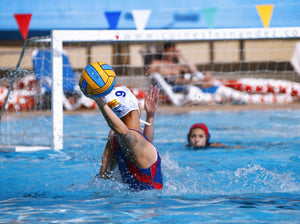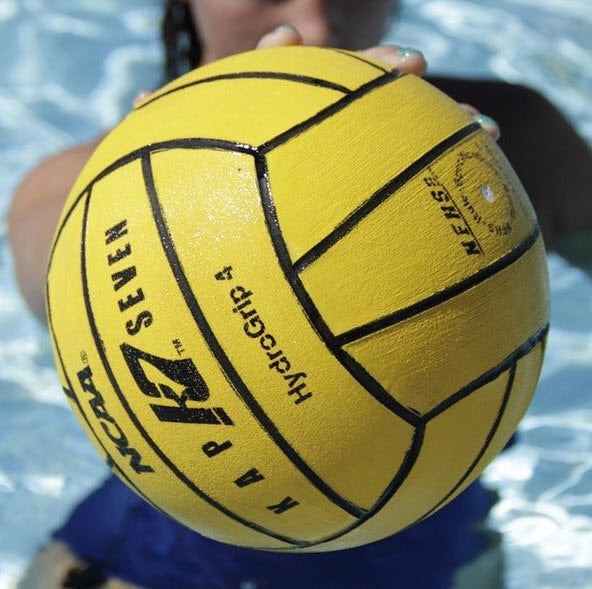How to Play a Five-meter Call in Water Polo
A five-meter call is the only time during a water polo game that a player is awarded a free shot on the goal. Five-meter calls are made when the defending team makes an illegal effort to prevent a shot on goal. The severity (and rarity) of a five-meter call is one step beyond that of an exclusion. Five-meter calls often confuse new players who may not know where they have to be during the shot or how to set up in case the shooter does not score. This guide explains the basics of five-meter calls, shooting strategies, and how the rest of the offense should set up during a five-meter call.
What is a Five-meter?
Rarer than regular fouls and exclusions, five-meter calls afford the recipient a free shot on goal from the five-meter line (hence the name). A five-meter call is indicated by the referee with one loud whistle blast and a raised hand with all five fingers extended.
The team may choose which player they want to take the shot and be given time to set up for it. The referee will blow the whistle, and the player will immediately shoot. If they do not score, the ball is then free for either team to establish possession.
The following circumstances are grounds for a five-meter call:
- For a foul or act of brutality committed within the five-meter area that prevented a probable goal.
- If the defending team moved or displaced the goal in order to block a shot.
- For a defending player (other than the goalkeeper) to block a shot or pass with two hands.
- For the defending team to take the ball underwater when tackled.
- For a player not authorized to play at that time (whether because they are excluded, or on the bench) to intentionally interfere with the game.
- For a defending player to hit the ball with a clenched fist.
- For the coach of the team not in possession of the ball to request a timeout or for a team official to take any action to prevent a probable goal. No personal foul will be recorded in this case.
Even though the player who caused the five-meter gets a personal foul point against them (three total and they will be ejected from the game), they do not leave the field of play as they would for an exclusion call.
How to Shoot
 The rules for the five-meter shooter are simply that they must be on the five-meter line. The shooter's position can be along any point of the five-meter line, but most players opt for the center of the goal because it affords them the widest range of shooting possibilities. The goalkeeper must be between the goal posts with no part of their body extending past the goal line above the water. No other players can be between the five-meter line and the goal, or within two meters of the shooter.
The rules for the five-meter shooter are simply that they must be on the five-meter line. The shooter's position can be along any point of the five-meter line, but most players opt for the center of the goal because it affords them the widest range of shooting possibilities. The goalkeeper must be between the goal posts with no part of their body extending past the goal line above the water. No other players can be between the five-meter line and the goal, or within two meters of the shooter.
The five-meter shot must be fired when the referee blows their whistle. No pause is allowed. Any type of shot is allowed for a five-meter, with the single requirement that the shooter stays in one place and that the shot comes from one uninterrupted movement. Shooters are not allowed to pump fake, move from side to side, advance towards the goal, or transfer the ball from one hand to the other before firing.
It does, however, leave shooters with a surprising number of options, including:
- Power shots
- Skip shots
- Backhand shots
- Sweep shots
Shots that can be fired to a high corner (usually power or skip shots) are the most difficult to block. If the goalkeeper has a known weak side, this is the perfect time to capitalize on that knowledge. It is important to practice five-meter shots ahead of time to both improve aim and to determine which shot will be the most reliable when the time comes.
Players should practice looking at one corner of the goal, but shooting to the other. Since five-meter shooters cannot pump fake, this is one way they can try to throw the goalkeeper off. Desperate for a hint as to where the ball is going, the goalkeeper will probably lunge to the wrong side.
How the Rest of the Offense Should Set Up
The strongest setup for the rest of the field players on offense is to keep at least two teammates on the five-meter line — one either side of the shooter — so they can help retrieve a rebound or blocked shot. It is also a good idea for the remaining field players to drop back in preparation for defense in case the shot does not go in and the defense gets possession. They should match up with the defensive players, probably also dropping back in anticipation of a block, who represent the biggest threat. As always, the players in the center and closest to the goal should be covered first.
After the Shot
There are a few possible outcomes from a five-meter shot. The first is that the shooter scores. If the shooter does score, the teams will line up at the half just as they would after any other goal. The second possible scenario is that the goalie blocks the shot and retains possession of the ball. In this case, there is a turnover, and the teams will have to quickly transition to the other end of the pool. The final outcome is that the shooter does not score but their team retains possession of the ball after the rebound. They now have a new shot clock and can set up a regular offense to try to score again.
The Pressure Is On
Five-meters are an intense moment, both for offense and defense. If the pressure is too much, there is no shame in asking another player to take the shot. In fact, most teams rely on a couple of players with dependably accurate shots to take their five-meters. Because of the high pressure of the moment, many players are prone to make mistakes. This makes it valuable to run through a five-meter strategy in practice. When a five-meter is called during a game, there should be a set strategy in place so that players can quickly and confidently make the most of the call.



